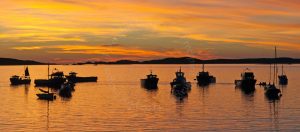Sunsets – now, the sun generally sets at far more sociable hours and that is why, I have little doubt, there are so many more sunsets than sunrises bouncing around the photo world 🙂
Again, similar to sunrises, sunsets can be photographed for their own beauty or for the amazing light they can cast on the landscape. For example, I live near a beautiful stretch of coast, The Glamorgan Heritage Coast, which has stretches of yellowy, orangey oolitic limestone cliffs. This is a photography heaven as we now have choices of ‘into the sun’, and ‘with backs to the sun’, picking up the orange glow. In between the sunrise and the sunset is pretty good here too. Granite, by the way, is another rock that glows orange when the sunset light hits it.
Sunsets
My approach to sunsets is broadly similar to sunrises. I make sure I am on location well before the sun actually dips below the skyline BUT this time I will wait for a good 30 to 45 minutes after as well, as this is often the time when the vanished sun throws out amazing light that has a wonderful illuminating effect on the sky. How many folk have I watched packing up their gear when the sun disappears and they have missed this! Also, it gives plenty of time to position yourself to best advantage looking for a good foreground, if appropriate.
Again like a sunrise shoot, the location is checked and the forecast reviewed. A great tool for this is The Photographer’s Ephemeris – available as an app or on the big screen. Google it! It gives times, directional info and all sorts of very helpful information.
My preferred ‘in camera’ option for metering is matrix/segment metering – that way the whole of the scene is measured and averaged out rather than just one very bright area. We can always use exposure compensation (+/-) if the histogram is too far to the left or right, and we can re-align in post processing to finesse the shot later.
Consider, also, if you want the sun as a feature of the shot, a golden ball slipping slowly out of view, OR if you want to show the effects of the sunset light, with your back to the sun, showing beautiful light on say, the landscape in general or specifically a row of cliffs. If you do this however, be aware that your shadow will fall into the shot if you opt for a wide lens! A sort of shadowy selfie.
Of course, you can and maybe should do both! Secure every possibility out of the shoot.
Generally, and this is general as each location etc will call for different setups, I ALWAYS use a tripod. I try to use lens lengths from around 24mm (wider than that and the landscape is pushed too far back – be wary of your shadow photo bombing you) and 200mm – for sun/sky/landscape close ups. I also, time permitting, try for both landscape AND portrait format – the latter can look much more dramatic. I set the camera to A(perture) and dial in around f8. Too high and you run the risk of blur as the sun moves. That said, if the light is fairly brightish an aperture of f22 can give a great star or sunburst effect, especially if you are able to catch the sun just before it dips below the skyline! I aim for a low ISO to maintain picture quality – around 100 – and rely on the tripod’s stability to accommodate a longer exposure if that is how it turns out.
Watch out, too, for flare – that phenomenon which appears as a circle, an octagon, stripes etc when direct sunlight gets into the barrel of the lens. Always use a lens hood and or carry a sheet of A4 card or similar to hold in front of the lens to remove this ‘stray light’. You may want flare – it can add to a shot – but at least be aware of it.
One of the shots below, whilst I can hardly claim the approach to be original, is an attempt to just add a little ingredient in to make it a bit different!
Thinking about it, and this equally applies to sunrises as well, consider if a crop may strengthen the picture? Square, panoramic (less sky and less foreground), try it and see what you think – some of the shots below have been cropped.
This is not definitive, and you will find your own ‘best way’, but this may help you to get started, or restarted! I would love your thoughts.

Clarach Bay Sunset Cardigan Bay West Wales with a long lens and the sun positioned roughly on the third

Sunset over the Scillies – view from St Mary’s west towards Bryher cropped to remove a band of plain blue sky






Leave a Reply